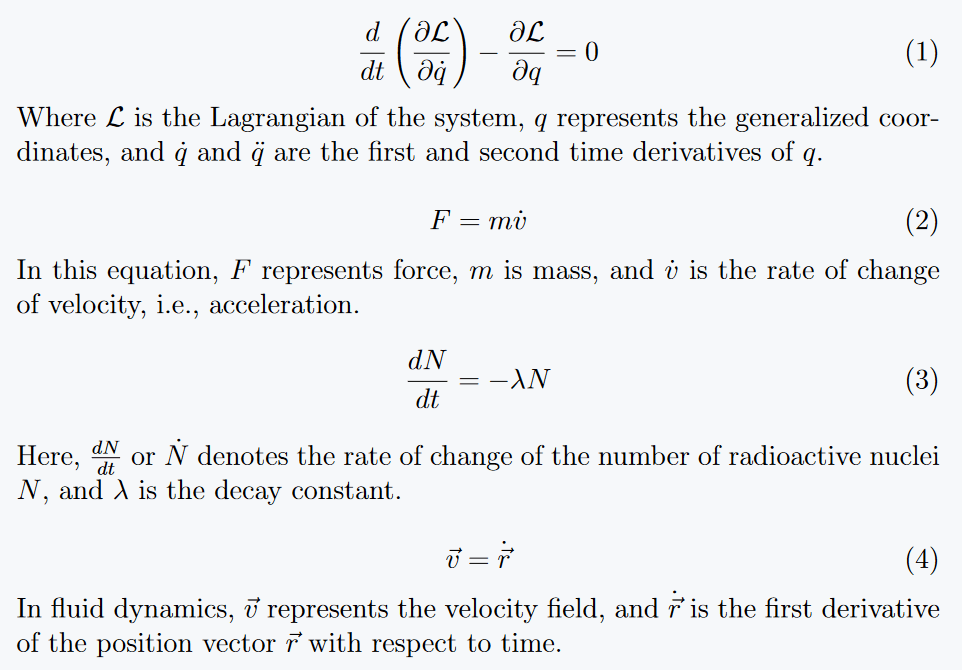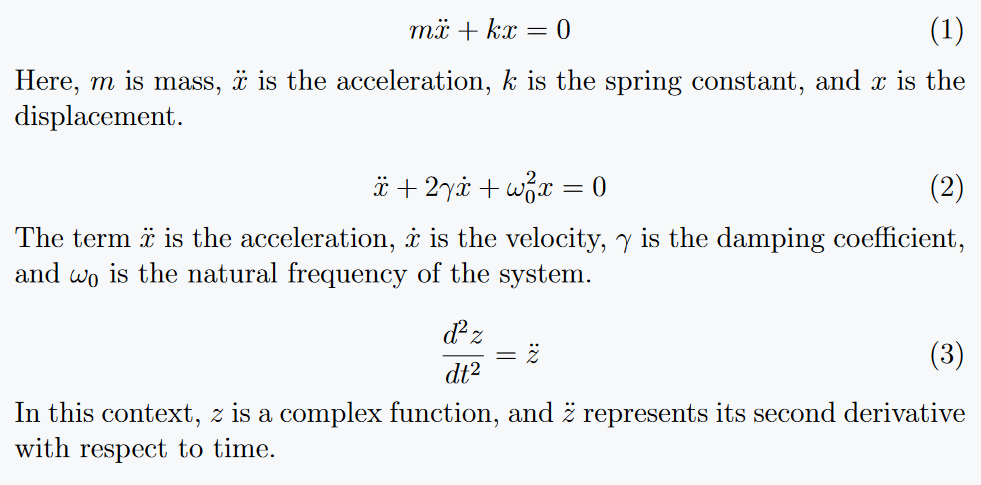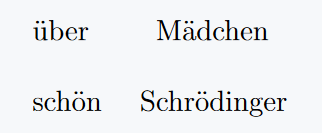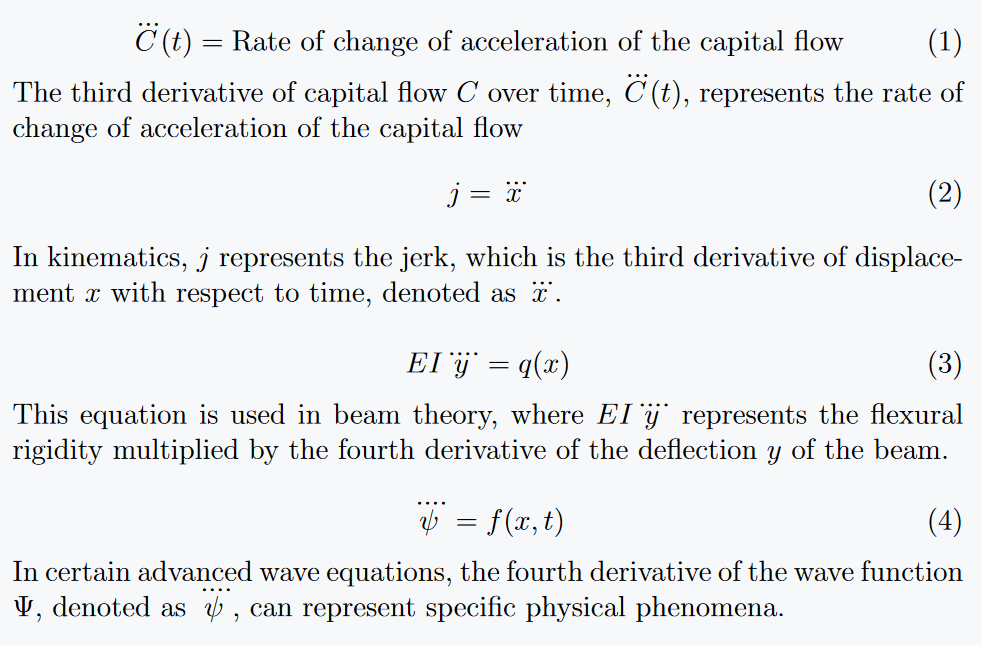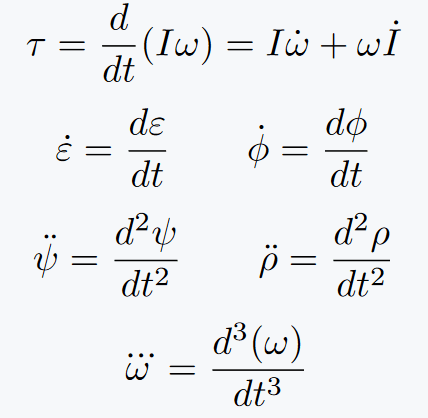Use of dots over letters can be seen in everything from languages to math and physics. And you’ll notice, dot is used over the Greek symbol in various physics expressions.
In this tutorial we will look at everything in depth.
Adding a single dot above letter in LaTeX is particularly useful in mathematical and scientific documentation, where it is often used to denote derivatives or other specific notations.
Use single dot above letter
The \dot{arg} command in LaTeX is used to place a single dot above a character. In the argument, pass letter or symbol on which you want to see the dot.
\documentclass[12pt]{article}
\begin{document}
\begin{equation}
\frac{d}{dt} \left( \frac{\partial \mathcal{L}}{\partial \dot{q}} \right) - \frac{\partial \mathcal{L}}{\partial q} = 0
\end{equation}
Where \(\mathcal{L}\) is the Lagrangian of the system, \(q\) represents the generalized coordinates, and \(\dot{q}\) and \(\ddot{q}\) are the first and second time derivatives of \(q\).
\begin{equation}
F = m \dot{v}
\end{equation}
In this equation, \(F\) represents force, \(m\) is mass, and \(\dot{v}\) is the rate of change of velocity, i.e., acceleration.
\begin{equation}
\frac{dN}{dt} = -\lambda N
\end{equation}
Here, \(\frac{dN}{dt}\) or \(\dot{N}\) denotes the rate of change of the number of radioactive nuclei \(N\), and \(\lambda\) is the decay constant.
\begin{equation}
\vec{v} = \dot{\vec{r}}
\end{equation}
In fluid dynamics, \(\vec{v}\) represents the velocity field, and \(\dot{\vec{r}}\) is the first derivative of the position vector \(\vec{r}\) with respect to time.
\end{document}
Output :
The \.{arg} command in LaTeX is used to place a dot accent over a character in text mode.
This is different from \dot{arg} command used in math mode for denoting derivatives. Dot accent is commonly used in various languages to modify sound of the letter it accompanies.
\documentclass[12pt]{article}
\begin{document}
1. The uppercase version of the Turkish letter 'i' is written as \.{I}, which has a dot above it. \\
2. The Lithuanian alphabet includes the letter \.{E}, which is an 'E' with a dot above it.\\
3. For stylistic purposes, you might use a dotted letter, like \.{A},\.{O}, \.{v}, \.{x}, \.{Z}.
\end{document}Output :
Use double dot above letter
The \ddot{arg} command in LaTeX is designed to place two dots above a character.
\documentclass[12pt]{article}
\begin{document}
\begin{equation}
m\ddot{x} + kx = 0
\end{equation}
Here, \(m\) is mass, \(\ddot{x}\) is the acceleration, \(k\) is the spring constant, and \(x\) is the displacement.
\begin{equation}
\ddot{x} + 2\gamma\dot{x} + \omega_0^2x = 0
\end{equation}
The term \(\ddot{x}\) is the acceleration, \(\dot{x}\) is the velocity, \(\gamma\) is the damping coefficient, and \(\omega_0\) is the natural frequency of the system.
\begin{equation}
\frac{d^2z}{dt^2} = \ddot{z}
\end{equation}
In this context, \(z\) is a complex function, and \(\ddot{z}\) represents its second derivative with respect to time.
\end{document}Output :
The \"{arg} command in LaTeX is used to place an umlaut or a diaeresis over a character in text mode.
This diacritical mark consists of two small dots placed over a letter and is used in several languages to indicate a change in pronunciation.
\documentclass[12pt]{article}
\begin{document}
\"{u}ber \qquad M\"{a}dchen \\
sch\"{o}n \quad Schr\"{o}dinger
\end{document}Output :
For three and four dots
LaTeX has \dddot{arg} and \ddddot{arg} commands for three dots and four dots. But, for this you need to insert amsmath package in preamble.
\documentclass[12pt]{article}
\usepackage{amsmath}
\begin{document}
\begin{equation}
\dddot{C}(t) = \text{Rate of change of acceleration of the capital flow}
\end{equation}
The third derivative of capital flow \(C\) over time, \(\dddot{C}(t)\), represents the rate of change of acceleration of the capital flow
\begin{equation}
j = \dddot{x}
\end{equation}
In kinematics, \(j\) represents the jerk, which is the third derivative of displacement \(x\) with respect to time, denoted as \(\dddot{x}\).
\begin{equation}
EI\ddddot{y} = q(x)
\end{equation}
This equation is used in beam theory, where \(EI\ddddot{y}\) represents the flexural rigidity multiplied by the fourth derivative of the deflection \(y\) of the beam.
\begin{equation}
\ddddot{\psi} = f(x, t)
\end{equation}
In certain advanced wave equations, the fourth derivative of the wave function \(\Psi\), denoted as \(\ddddot{\psi}\), can represent specific physical phenomena.
\end{document}Output :
Dot over Greek symbol
Not just above the letter. You can easily use this dot over symbols if you want. Just pass the symbol command instead of letter.
\documentclass{article}
\usepackage{amsmath}
\begin{document}
\[ \tau = \frac{d}{dt}(I\omega) = I\dot{\omega} + \omega\dot{I}\]
\[ \dot{\varepsilon} = \frac{d\varepsilon}{dt} \qquad \dot{\phi} = \frac{d\phi}{dt}\]
\[ \ddot{\psi} = \frac{d^2\psi}{dt^2} \qquad \ddot{\rho} = \frac{d^2\rho}{dt^2}\]
\[ \dddot{\omega} = \frac{d^3(\omega)}{dt^3} \]
\end{document}
Output :
